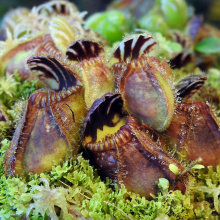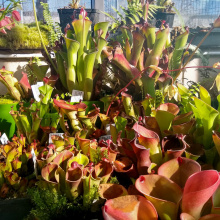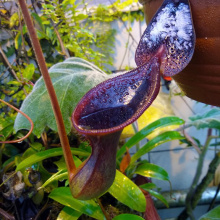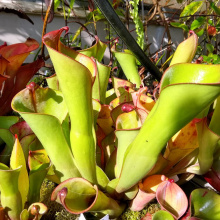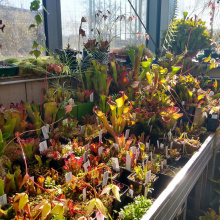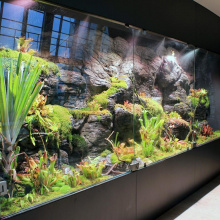Nepenthes hamata (Gunung Lumut, Sulawesi, Indonesia). Photo: dr hab. Krzysztof Banaś
Dr hab. Krzysztof Banaś, Professor UG from the Department of Plant Ecology of the Faculty of Biology, University of Gdańsk, the originator of the International Carnivorous Plants Day, is also the creator of the paludarium, which is located on the first floor of the Faculty of Biology building. It is there that we can admire carnivorous plants originating from the mountains of South America.
More about the events on the occasion of World Carnivorous Plants Day
The Paludarium, which opened in March 2019, reflects the conditions of the table mountains found in the heart of Venezuela's evergreen equatorial forests, making it possible to grow the plants found there. This is only possible if the right conditions are provided for them.
- 'It is particularly important to maintain high humidity in the soil and air, as well as to provide the plants with adequate light and night-time temperature drops. In the paludarium we manage to achieve such conditions using automatic sprinkling and air conditioning (24 degrees in the day, 18 at night), as well as additional lighting,' - says dr hab. Krzysztof Banaś, prof. UG. - 'The most unique and characteristic plants for the peaks of the table mountains are Heliamphora. These are carnivorous plants, whose leaves have been transformed into vertical, tubular pitchers up to 50 cm high. The leaves are green, in some species with red veins and others all red. The jugs have no lid, so they are largely filled with rainwater and the excess is drained off through a special slit. At the top of each jug is a species-specific appendage that secretes nectar, which is used to attract insects. Prey is also attracted by the sweet smell and colouration. The attracted insect slips inside the pitcher, where it drowns in the accumulated water.'
Let us recall - the construction of the paludarium was co-financed by the Regional Fund for Environmental Protection and Water Management in Gdańsk as part of the implementation of the task 'Selected groups of plants as promoters of the idea of preserving and protecting the diversity of species and habitats'.
Dr hab. Krzysztof Banaś on carnivorous plants:
Carnivorous plants are unique in the plant kingdom and produce modified leaves that attract, capture and kill insects and other small animals. Their compound leaves are often unusual in form and oddly coloured. Their specialised leaf traps can produce nectars, odours and even narcotics that play a role in the complex capture process that has evolved and been refined to maximise the successful capture of animal prey. Most carnivorous plants catch small insects, i.e. ants, bees, beetles, butterflies, flies, moths, spiders, wasps, and sometimes other types of animals, including crocodiles, scolopendra, scorpions and snails. Most plants capture microscopic animals, while some (like pitcher plants) can catch animals as large as vertebrates, including tadpoles, fry, frogs and, in rare cases, even rodents and birds.
For a plant to be classified as carnivorous, it must have adaptations that enable it to 1. to attract animals - usually through a sweet smell, nectar, distinct colouring or other visual effects; 2. to capture animals - through various forms of morphological adaptations of the leaves that directly or indirectly lead to the death of trapped prey; 3. to benefit from animal prey by absorbing nutrients released from it.
It has now been proven that about 750 plant species from seventeen genera are carnivorous plants. Two of these are known to have snap traps (Aldrovanda and Dionaea), seven genera of plants produce pitchers (Brocchinia, Catopsis, Cephalotus, Darlingtonia, Heliamphora, Nepenthes and Sarracenia), six genera produce sticky leaves (Drosera, Byblis, Drosophyllum, Pinguicula, Roridula, Triphyophyllum). In addition to these confirmed carnivorous plant taxa, there are three additional genera commonly suspected of being carnivorous (Ibicella, Proboscidea and Philcoxia).
By hunting for carnivorous animals, plants have developed a unique ability to assimilate nutrients that are unavailable to non-carnivorous plants, and thus can thrive in the most arid and inhospitable habitats for plants. Although all carnivorous plants have specialised adaptations to hunt animals, there are no carnivorous plants whose survival depends solely on carnivory. All these plants can obtain nutrients by photosynthesis, in most cases, also by root uptake. Therefore, carnivorous plants can grow well and reproduce even if they do not catch prey at all, but when they trap animals, the benefits to plant growth and flowering are very great.

